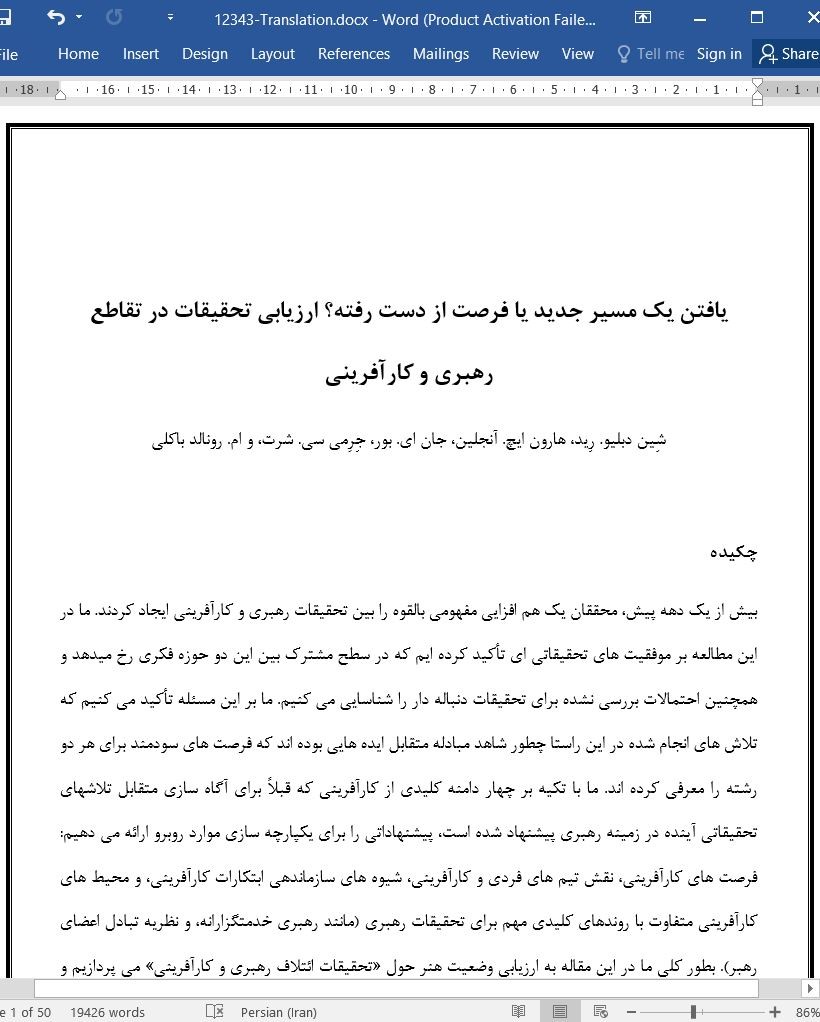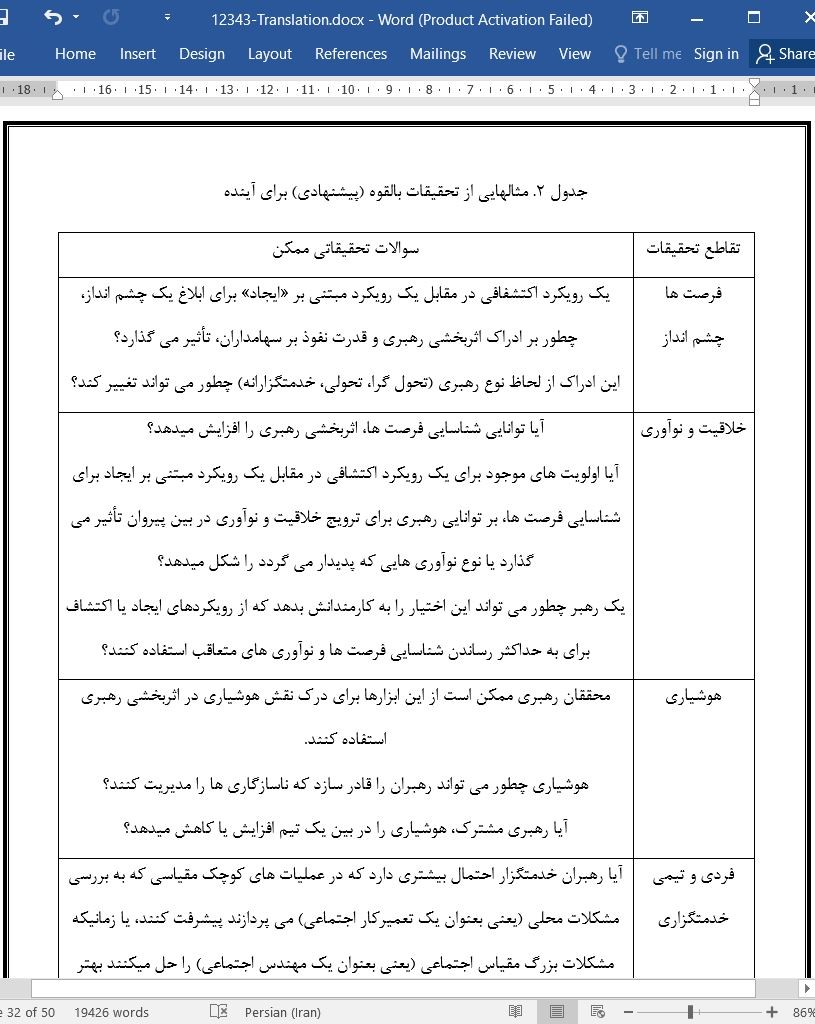
یافتن یک مسیر جدید یا فرصت از دست رفته؟ ارزیابی تحقیقات در تقاطع رهبری و کارآفرینی
چکیده
بیش از یک دهه پیش، محققان یک هم افزایی مفهومی بالقوه را بین تحقیقات رهبری و کارآفرینی ایجاد کردند. ما در این مطالعه بر موفقیت های تحقیقاتی ای تأکید کرده ایم که در سطح مشترک بین این دو حوزه فکری رخ میدهد و همچنین احتمالات بررسی نشده برای تحقیقات دنباله دار را شناسایی می کنیم. ما بر این مسئله تأکید می کنیم که تلاش های انجام شده در این راستا چطور شاهد مبادله متقابل ایده هایی بوده اند که فرصت های سودمند برای هر دو رشته را معرفی کرده اند. ما با تکیه بر چهار دامنه کلیدی از کارآفرینی که قبلاً برای آگاه سازی متقابل تلاشهای تحقیقاتی آینده در زمینه رهبری پیشنهاد شده است، پیشنهاداتی را برای یکپارچه سازی موارد روبرو ارائه می دهیم: فرصت های کارآفرینی، نقش تیم های فردی و کارآفرینی، شیوه های سازماندهی ابتکارات کارآفرینی، و محیط های کارآفرینی متفاوت با روندهای کلیدی مهم برای تحقیقات رهبری (مانند رهبری خدمتگزارانه، و نظریه تبادل اعضای رهبر). بطور کلی ما در این مقاله به ارزیابی وضعیت هنر حول «تحقیقات ائتلاف رهبری و کارآفرینی» می پردازیم و برنامه کاری را برای دهه بعدی تحقیقات در این تقاطع (فصل مشترک) تعیین می کنیم.
کارآفرینی موفقیت آمیز مستلزم رهبری مؤثر افراد، منابع و فرآیندهایی است که برای خلق ارزش های جدید استفاده می شوند. مثال های آن از نوآوری در یک سازمان موجود، تا خلق یک سرمایه گذاری (ابتکار مخاطره آمیز) کاملاً جدید متغیر می باشد (سیمسِک، جانسِن، مینی چیلی و اسکریبا-استیو 2015). بنابراین تحقیقات کارآفرینی با آشکارسازی این مسئله انجام میشود که کارآفرینی چطور و چرا رخ میدهد؛ این آشکارسازی با بررسی این سوالات انجام می شود که «چطور، توسط چه کسانی، و در کدام محیط، فرصت های معینی شناسایی و ارزیابی می شوند و برای خلق ارزش های جدید از آنها استفاده می شود؟» (شین 2012). با توجه به پیچیدگی های کلی و پویش شناسی اجتماعی موجود در فرآیند کارآفرینی، محققان اغلب از دیدگاه های نظری متعددی از زمینه های دیگر برای توضیح پدیده کارآفرینی استفاده میکنند (زهرا 2005).
نتیجه گیری
درک کیفیت های رهبران مؤثر و احتمالات اینکه کدام سبک های رهبری مؤثرتر هستند هنوز هم در حوزه رهبری به اندازه کافی مورد بررسی قرار نگرفته است. تعداد تحقیقاتی که بررسی میکنند رهبران چطور می توانند تأثیر مثبتی بر روی تلاشهای کارآفرینی داشته باشند، رو به افزایش است، و تعداد زیادی از مقالات هم بعد از آخرین مرور ما در این باره، منتشر شده اند. مرور (مقالات) ما نشان میدهد که تقاطع این دو حوزه همچنان نیازمند این است که محققان آینده این را بررسی کنند که پیشرفت های نظری در کارآفرینی چطور می تواند بینش های عمیق تری را در مورد اثربخشی رهبر فراهم سازد، پیشرفت های حاصل شده در رهبری چطور می تواند همچنان رفتار کارآفرینی را ترویج (گزارش) کند، و محیط های کارآفرینی چطور دامنه های جدیدی را فراهم می سازند تا نظریه رهبری را توسعه دهند یا آنرا محدود سازند. اگر اینطور باشد، دانش ما از رهبری کارآفرینی همچنان مانند یک حوزه تحقیقاتی پرثمر عمل خواهد کرد.
Abstract
More than a decade ago, scholars formally conceptualized the potential synergy between leadership and entrepreneurship scholarship. Our work highlights research accomplishments occurring at the interface of these two intellectual areas as well as identifying untapped possibilities for continued research. We highlight how recent efforts have witnessed a mutual exchange of ideas that present opportunities benefiting both fields. Drawing from four key domains of entrepreneurship previously proposed to mutually inform future leadership research efforts, we make suggestions for integrating entrepreneurial opportunities, the roles of individual and entrepreneurial teams, the modes of organizing entrepreneurial ventures, and differing entrepreneurial environments with key trends important to leadership research, such as servant leadership and leader-member exchange theory. Overall, our work provides an assessment of the state of the art surrounding the coalescence of leadership and entrepreneurship research and sets an agenda for the next decade of research at this intersection.
Successful entrepreneurship requires the effective leadership of people, resources, and processes to create new value. Examples range from innovation within an existing organization to the creation of an entirely new venture (Simsek, Jansen, Minichilli, & Escriba-Esteve, 2015). Entrepreneurship research is thus tasked with uncovering how and why entrepreneurship occurs by examining the how, by whom, and in what setting specific opportunities are identified, evaluated, and exploited to create this new value (Shane, 2012). Given the general complexities and social dynamics involved in the entrepreneurial process, scholars often leverage multiple theoretical lenses from other fields to explain entrepreneurship phenomena (Zahra, 2005).
Conclusion
Understanding the qualities of effective leaders and contingencies where certain leadership styles may be most effective remains the hallmark of the field of leadership. Research investigating how leaders may positively impact entrepreneurial endeavors is flourishing, with a substantial number of articles published since the last review on this topic. Our review suggests that the intersection of these two fields will continue to hold promise for future scholars to investigate how theoretical developments in entrepreneurship may provide deeper insight into leader effectiveness, how advancements in leadership can continue to inform entrepreneurial behavior, and how entrepreneurial settings provide new domains to extend and bound leadership theory. If so, our knowledge of entrepreneurial leadership will continue to act as a fecund area of inquiry.
چکیده
ما کجا بوده ایم؟
چشم انداز
نفوذ
خلاقیت و نوآوری
برنامه ریزی
رویکردهای گرایشی و شناختی
از اینجا به کجا می رویم؟
فرصت ها
افراد و تیم ها
شیوه سازماندهی
محیط ها
نتیجه گیری
منابع
ABSTRACT
Where have we been?
Vision
Influence
Creativity and innovation
Planning
Dispositional and cognitive approaches
Where do we go from here?
Opportunities
Individuals and teams
Mode of organizing
Environments
Conclusion
References
- اصل مقاله انگلیسی با فرمت ورد (word) با قابلیت ویرایش
- ترجمه فارسی مقاله با فرمت ورد (word) با قابلیت ویرایش، بدون آرم سایت ای ترجمه
- ترجمه فارسی مقاله با فرمت pdf، بدون آرم سایت ای ترجمه



